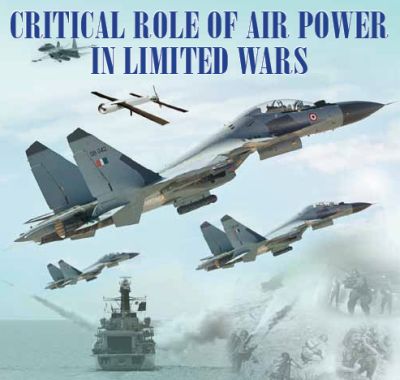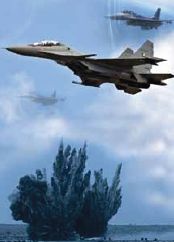This article is published with the kind permission of “Defence and Security Alert (DSA) Magazine” New Delhi-India
 |
A comprehensive analysis of the crucial role Air power will play in a Limited War against a nuclear backdrop in South Asia. There is a need to switch from deterrence by denial to deterrence by Punishment in the Indian Context. Deterrence by Punishment can be done much better by Air Power and even by Sea Power. Air power is precise, focused and flexible. It is most conducive to retaining escalation dominance and can set the stage for a Limited War designed to steeply raise costs for the Aggressor and bring to battle and seriously degrade his operational and Strategic reserves preferably in his own territory. India will therefore have to evolve and enunciate a Limited War Doctrine that exploits the current RMA by giving primacy to Air Power to be the first responders and if needed, set the stage for a wider Air-Land Battle designed to sharply escalate costs for the Enemy.
 |
| Click to enlarge |
Post nuclearisation the South Asian geo-strategic scenario has been shaped by what Chris Gagne calls the “Stability-Instability Paradox”. Stability at the Nuclear level has been offset by increasing instability at the sub-conventional level of conflict. There has been a concomitant sharp downturn in the use of Conventional Military Force as is evident from the force usage profile of India given below. This histogram indicates the number of Divisions employed by India in each conflict after Independence.
Thus from 1947 to 1962 the Indian Military usage was confined to the tactical level of 2–3 Divisions alone. However Air power played a significant role in Jammu and Kashmir, Hyderabad and Goa operations. Tragically offensive Air support was eschewed in the 1962 War against China though extensive air transport and logistics support was provided.
With the 1965 War the Indian Armed Forces graduated to the level of operational Art via use of 12 Divisions in combat and virtually the entire Western Command of the Air Force with reinforcement from other theatres also employed. Though this war was a stalemate it was a highly useful learning experience. It was with the 1971 War for the Liberation of Bangladesh that the Indian Armed Forces graduated to the level of conducting a Quasi total war. The Indian Air force gained Air Supremacy over Bangladesh. It massed effects and induced shock and awe. It paved the way for a decisive war with spectacular results. A decisive war in the Post World War II context is characterised by the ability to march on the adversary national capital and enforce regime change. This is precisely what was done. A new country was created with the force of arms and over 93,000 prisoners of war were taken. This spectacular victory marks the apogee of Indian Military Power in the post-Independence era.
 |
1987 saw the onset of recessed deterrence and a sharp curtailment in the use of conventional military force. The economic setback of 1990 thereafter severely constrained response options and from the decade of the 1980s till today — India completely surrendered the strategic and tactical initiative to Pakistan. Pakistan’s ISI waged an asymmetric war first in Punjab and then in Jammu and Kashmir. India’s response was reactive and purely defensive in nature and strictly confined to its own territory.
1998 saw overt nuclearisation and that marked a paradigm shift in South Asia. It generated hubris in Pakistan and led to the Kargil Intrusion — a hybrid war response that clearly marked a new threshold in Pakistan’s asymmetric war against India. Indian response was innovative but confined to the tactical level of two Divisions supported by Air Power but confined to our side of the LC. This was a Limited War highly localised in space but extended in time to almost three months of attrition and direct frontal assaults in the mountains.
This was followed by the Terrorist attack on India’s Parliament and our mobilisation for War in terms of Op Parakram. The flaw was the ‘all or nothing’ nature of this deployment. No combat took place and the coercive effect of this mobilisation wore off over time. This generated considerable angst and the Indian Army came up with the Cold Start Doctrine of attack from the Line of March to make shallow penetrations all along the Western Front.
Cold Start suffered from serious conceptual flaws. The Political Masters and other two Services were not taken on board. The use of land forces to initiate conflict would generate tremendous fog of war and could breakdown escalation control. Land forces once launched cannot be easily disengaged / called back. Shallow penetrations are half-baked conventional response options. What if the enemy reacts with full fledged Strike Corps offensives in response to divisional sized thrusts?
There is a need to switch from deterrence by denial to deterrence by Punishment in the Indian Context. Deterrence by Punishment can be done much better by Air Power and even by Sea Power. Air power is precise, focused and flexible. It is most conducive to retaining escalation dominance and can set the stage for a Limited War designed to steeply raise costs for the Aggressor and bring to battle and seriously degrade his operational and Strategic reserves preferably in his own territory. This would actualise deterrence by punishment.
The response to asymmetric terrorist strikes is far better initiated by Air Power which target in a precise and proportionate manner those terrorist facilities, camps and infrastructure used to initiate the attack. This would make our response just and proportionate. Any enemy retaliation / response would then justify our graduation upwards on the escalation ladder.
A good model for such a campaign is the Israeli Air Forces decimation of the Syrian Air Force in the invasion of Lebanon in 1982. This would set the stage for a Limited War in the Air-Land Battle format — to steeply raise costs for Pakistan for its asymmetric adventurism.
Limited war doctrine
India will therefore have to evolve and enunciate a Limited War Doctrine that exploits the current RMA by giving primacy to Air Power to be the first responders and if needed, set the stage for a wider Air-Land Battle designed to sharply escalate costs for the Enemy. There was considerable discussion on the concept of Limited War in the wake of the Kargil operations. This debate was initiated by Air Cmde Jasjit Singh (then the Director IDSA). Significant contributions were made by the then Army Chief Gen Ved Malik and the then Raksha Mantri Mr George Fernandez. Surprisingly within three years — this debate had died out altogether and this very welcome initiative was not taken forward.
1998 saw overt nuclearisation and that marked a paradigm shift in South Asia. It generated hubris in Pakistan and led to the Kargil intrusion — a hybrid war response that clearly marked a new threshold in Pakistan’s asymmetric war against India. Indian response was innovative but confined to the tactical level of two Divisions supported by air power but confined to our side of the LC. This was a Limited War highly localised in space but extended in time to almost three months of attrition and direct frontal assaults in the mountains
There is a considerable body of literature available in the West on Limited Wars against a Nuclear Backdrop. Korea was the First such Limited War and lasted some three years. The Chinese threw in almost a million troops and fought the US to a standstill. The US suffered over 1,37,000 soldiers killed in this Limited War where the Chinese completely ignored the nuclear threshold. Gen Mac Arthur was sacked when he asked for the use of atomic weapons against the Chinese. Bernard Brodie and William Kaufman were the chief theorists of limited war. Kaufman used the experience of the Korean war to theorise about nuclear thresholds and redlines. He identified the primary Limitation as the non-use of nuclear weapons. The Cuban Conflict validated his theories and helped America transition from massive response to flexible response. The Vietnam war was the second form of conflict to breakout in a backdrop of nuclear symmetry. Though classed as Low intensity Conflict it saw the US deploy 5,49,000 troops and launch a massive air campaign (Op Rolling Thunder) against North Vietnam. Henery Kissinger tried to popularise the concept of a Limited Nuclear War but this hardly carried conviction and was never put to the test.

 von
von 
